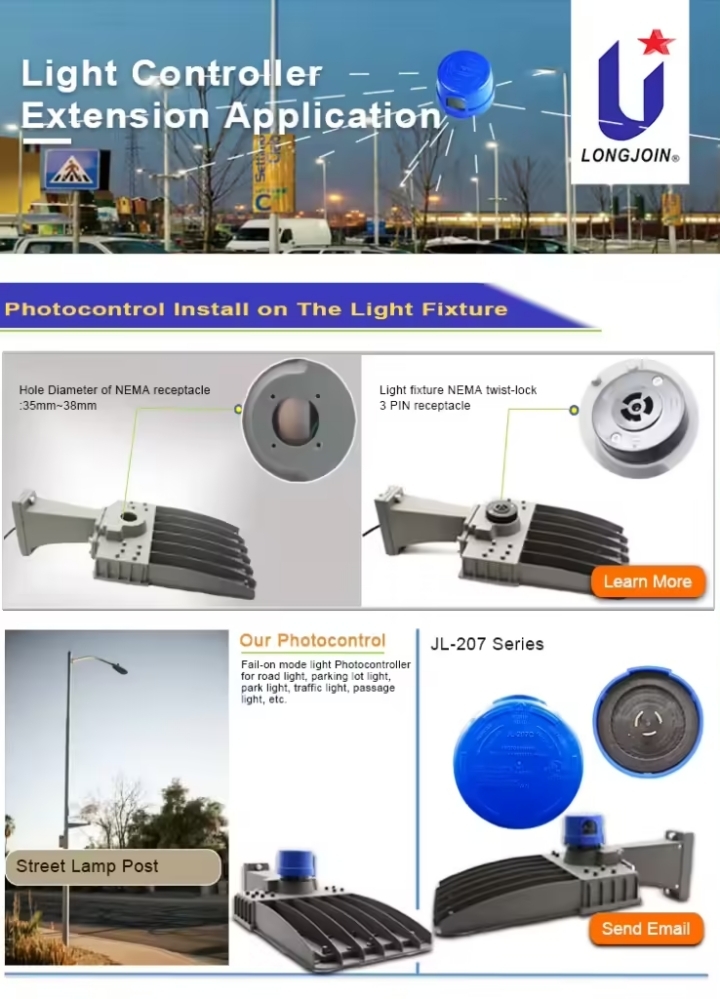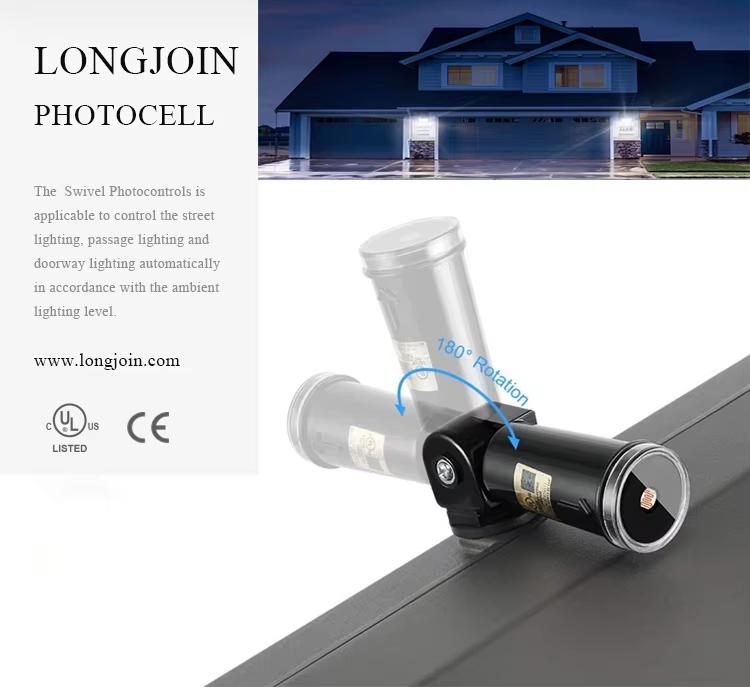Outline
- Introduction
- Why Do Certifications Define the Quality and Reliability of Photocell Switches?
- What Is UL 773 and Why Is It the Cornerstone of Photocontrol Safety?
- How Does ANSI C136.10 Ensure Interchangeability And Compatibility?
- Why Is Zhaga Book 18 the New Standard for Smart Lighting Integration?
- Which Certification Should You Prioritize for Your Market?
- How Does Shanghai Long‑Join Electronics Co., Ltd. Maintain Global Compliance and Trust?
- The Bottom Line
What makes a photosensor truly reliable in the global lighting market?
It’s not just design or price. It’s a certification. They define whether a product is safe and future-ready. Without them, lighting systems risk failure or safety hazards.
For manufacturers and EPC contractors, understanding these standards is essential. Let’s uncover what each certification means, and which ones truly matter for your next lighting project.

Why Do Certifications Define the Quality and Reliability of Photocell Switches?
Certifications serve as the validator that a photocell lighting sensor will perform reliably in real-world outdoor lighting systems. They serve as a testimony to the product’s testing for electrical safety and material integrity.
Without them, manufacturers face a higher risk of non-compliance or liability claims from failures.
In the lighting market, certified products enable smoother acceptance in tenders and inspections. The major certifications to watch are:
- UL 773 for safety in North America.
- ANSI C136.10 for mechanical/electrical interface compliance of twist-lock photocontrols.
- Zhaga Book 18 for smart-lighting sensor interface and future-proofing.
What Is UL 773 and Why Is It the Cornerstone of Photocontrol Safety?
UL 773 is the North American safety standard for plug-in, locking-type light sensor photocell switch used in outdoor area lighting. It covers light-sensitive control units rated at up to 480 V AC and their receptacle devices.
Its scope includes:
- Electrical safety
- Mechanical integrity and
- Fire-resistance of the housing and materials
UL 773 Matter for Manufacturers
In U.S. and Canadian outdoor-lighting projects, UL 773 shows a product has undergone certified testing. That gives manufacturers and contractors confidence in compliance and installs.
Using non-UL-773 devices can lead to inspection failures or even liability in case of fire or electrical fault. Given that many utility or government tenders require UL certification, UL 773 becomes a baseline credential for market entry.
Shanghai Long‑Join Electronics Co., Ltd. Meets UL 773 Standards
Long-Join lists multiple product lines where photocontrols are UL-listed per UL 773 requirements. For example, its JL-207, JL-217 & JL-205C series are stated as “meet the requirements of ANSI C136.10 and ANSI/UL 773 for plug-in, locking-type photocontrols”.
The company promotes its UL 773-compliant portfolio as enabling safe entry into the North American lighting market and supporting major brands.

Further below is a table outlining common UL773 test parameters and their purpose.
| Test Parameter | Purpose | Ensured Performance |
| Dielectric Voltage Withstand | Checks insulation strength | Prevents electric shock or short circuit |
| Temperature Rise | Measures heat tolerance | Ensures safe operation in high-load environments |
| Endurance (On/Off Cycles) | Simulates long-term use | Verifies mechanical and electrical durability |
| Surge Immunity | Tests resistance to voltage spikes | Protects against lightning and grid surges |
| Flame Retardancy | Examines fire resistance | Ensures enclosure safety under fault conditions |
How Does ANSI C136.10 Ensure Interchangeability And Compatibility?
This standard sets the mechanical and electrical interface requirements for locking-type light sensors and their mating receptacles. Most of these products are used in roadway and area lighting.
It ensures that dusk-to-dawn photocells and receptacles from different manufacturers can be physically and electrically interchanged.
Key interface aspects covered include:
- Plug and receptacle dimensions and blade configuration.
- Sealing and mounting requirements to ensure durability in outdoor environments.
- Electrical performance, including load and surge tests for compatibility.
ANSI C136.10 is Critical for Outdoor Lighting Projects
For large‐scale outdoor lighting installations, interchangeability is vital. ANSI C136.10 assures that a photoelectric sensor from one vendor will fit a receptacle from another without custom adaptation. That avoids compatibility issues when replacing units or sourcing parts across manufacturers.
Many utilities, municipalities, and EPC contractors favour this standard because it brings flexibility and simplifies procurement and maintenance.
For example, the ANSI part of the equipment specification helps prevent downtime due to mismatched parts or proprietary interfaces.
Shanghai Long‑Join Electronics Co., Ltd. Deliver ANSI-Compliant Photocells
Long-Join offers photo switch sensors and sockets explicitly designed to meet ANSI C136.10 interface criteria. Their JL-207 and JL-217 series, for example, are described as ANSI‐compliant twist-lock photocontrols for outdoor lighting.
These are deployed in street light and industrial park applications. Because they adhere to the standardized interface, they enable plug-and-play replacements and global acceptance for lighting systems requiring interchangeability across brands.
Why Is Zhaga Book 18 the New Standard for Smart Lighting Integration?
Zhaga Book 18 establishes a standardised mechanical, electrical, and data interface between outdoor luminaires and sensing or communication modules. It ensures plug-and-play compatibility so any certified sensor or module can mate with any certified luminaire.
Typical specifications include:
- Voltage taps
- Communication bus (e.g., DALI), and
- Physical socket geometry designed for outdoor conditions
Zhaga Book 18 is Vital for Future Lighting Projects
This standard promotes interoperability across lighting brands and components. This effectively eliminates vendor lock-in. It enables IoT street lighting with upgradeable modules for sensors and control.
In Smart-cities in Asia and Europe, where flexibility and future-proofing are key, their adoption is increasing.
Shanghai Long‑Join Electronics Co., Ltd. Support Zhaga Book 18
Long-Join provides lighting control and sensors that are Book 18-compliant. This enables modular upgrade paths for smart lighting systems.

Their JL-700 series, for example, supports the Book 18 interface and can integrate communication protocols. The table below discusses them along with their details. This design supports next-generation street lighting systems, offering modularity and future readiness.
| Protocol | Range | Data Rate | Network Type |
| DALI-2 | Up to 300 m (wired) | Up to 9.6 kbps | Bus-based |
| ZigBee | 10–100 m | Up to 250 kbps | Mesh |
| LoRa | 2–10 km (urban), 15+ km (rural) | 0.3–50 kbps | Star (LoRaWAN) |
| NB-IoT | Up to 10 km | 20–250 kbps | Cellular |
| Wi-Fi | 50–100 m | Up to 150 Mbps | Star |
Which Certification Should You Prioritize for Your Market?
This depends heavily on your market and project type. Below is a clear comparison:
| Market / Application | Must-Have Certification | Why It Matters |
| North America | UL 773 and ANSI C136.10 | Ensures product safety and interchangeability. |
| Europe & Smart Cities | Zhaga Book 18 | Enables IoT readiness, interoperability, and smart-lighting compatibility. |
| Global Export | UL + CE + RoHS | Covers safety, environmental compliance, and global tenders. |
How to Choose the Right Certification Mix
| Lighting Project Type | Recommended Certifications | Key Purpose |
| Traditional Outdoor Lighting | UL 773 ANSI C136.10 | Ensures electrical safetyStandardized twist-lock interfaceReliable interchangeability |
| Smart Lighting Systems | Zhaga Book 18 | Data connectivitySensor integrationModular upgrades for IoT-based lighting |
| Global Export-Oriented Brands | UL + CE + RoHS + Zhaga | Achieves worldwide complianceSupports safety and environmental standardsEnhances market access |
How Does Shanghai Long‑Join Electronics Co., Ltd. Maintain Global Compliance and Trust?
Long-Join operates a rigorous multi-standard certification framework. Their product range includes certifications such as:
- UL 773
- ANSI C136.10
- Zhaga Book 18
- CE
- RoHS and
- ISO 9001:2015
Their manufacturing facility supports large-scale yet quality output. Long-Join also holds dozens of patents, signifying innovation and intellectual-property strength.
The company lists major global brands like Philips and Cree as partners or clients. This underlines its credibility in export markets and large-scale contracts. Furthermore, their OEM/ODM capability enables customised solutions for international lighting brands under fully-certified standards.
The Bottom Line
Choosing the right certification shapes the safety, reliability, and global reach of every lighting project. These standards define real performance and trust. For certified, globally compliant Long-Join photocontrollers, Chi-Swear remains a dependable partner trusted by major lighting brands worldwide.
External Links
- http://www.julixing.com.cn/en/new/new-58-907.html
- https://www.ansi.org/
- https://www.zhagastandard.org/?view=article&id=64:book-18&catid=10
- https://www.ul.com/solutions
- https://www.dali-alliance.org/dali2/comparison.html
- https://en.wikipedia.org/wiki/Zigbee
- https://en.wikipedia.org/wiki/LoRa
- https://en.wikipedia.org/wiki/Narrowband_IoT
- https://single-market-economy.ec.europa.eu/single-market/goods/ce-marking_en
- https://en.wikipedia.org/wiki/RoHS






